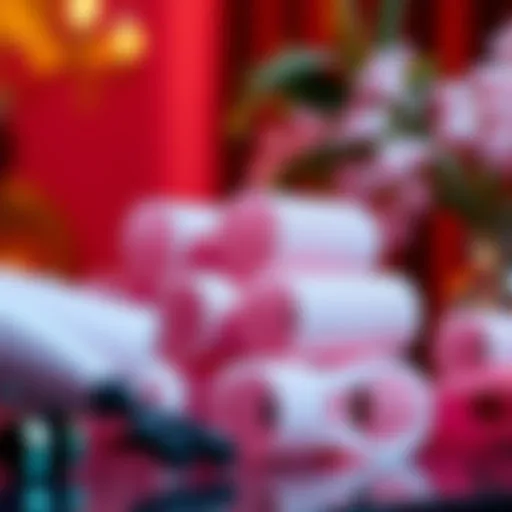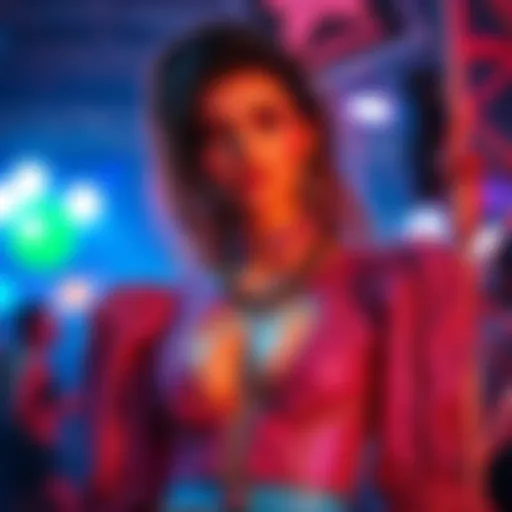Exploring Color Block Designer Handbags: A Guide
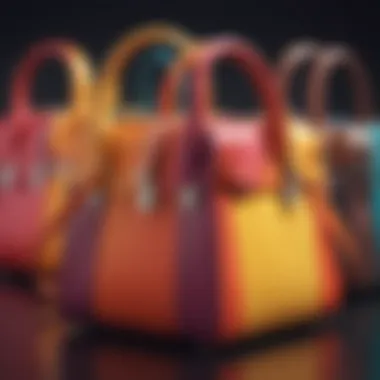

Intro
Color block designer handbags have firmly carved out a niche in the fashion landscape, captiviting attention with their bold hues and unique patterns. These bags tell a story; they embody creativity, making statements that transcend mere functionality. From the runways of Milan to street style-saturated cities, color blocking is more than a trend; it’s a celebration of self-expression and individuality.
This guide aims to provide insights into the multifaceted realm of color block handbags. It will explore their evolution, examining how they’ve transformed from niche designs to mainstream essentials. The allure of these handbags lies not only in their aesthetic appeal but also in the craftsmanship that brings them to life. Moreover, we'll delve into current trends, practical styling techniques, and care tips tailored to preserve these vibrant pieces.
Fashion Trends
Current Season Highlights
As we navigate through the season, color block handbags continue to dominate the scene. Designers are experimenting with unexpected color combinations, echoing both past influences and contemporary tastes. For instance, electric blue paired with neon orange reflects an audacious spirit, while soft pastels juxtaposed with earthy tones offer a cooler, more subdued elegance.
Some notable trends include:
- Monochromatic Pairings: A single color blocked with various shades creates a cohesive yet striking effect.
- Geometric Patterns: Clean lines and shapes are being embraced, shaping accessories that double as mini canvases.
- Mixed Mediums: Bags that combine leather, canvas, or even textiles introduced fresh textures, inviting tactile engagement.
Iconic Looks Through the Ages
The history of color blocking in fashion can be traced back to influential designers, such as the late Yves Saint Laurent, who, in the 1960s, famously utilized vibrant hues in his designs. Fast forward to the 80s, where the likes of Gianni Versace took the reins, injecting pop art aesthetics into haute couture. Each era adds a layer to the understanding of color blocking in handbags.
A few iconic examples include:
- The Baguette Bag by Fendi: This bag showcased playful color blocking, encapsulating the essence of 90s style.
- Chanel’s Color Block Collection: A modern take on classic designs, these pieces marry sophistication with a playful spirit.
"Color blocking is a form of art, where the canvas is a handbag and the colors speak for themselves."
Fabric Care Tips
Being mindful of the materials involved in color block handbags ensures their longevity and beauty.
Washing and Maintenance Guidelines
Proper maintenance can be tricky with vibrant colors, especially when fabrics are mixed. Here are key points:
- Spot Clean Regularly: Use a damp cloth to remove any stains promptly.
- Avoid Harsh Chemicals: Use gentle cleaners; harsh substances may cause colors to bleed.
- Store Appropriately: Keeping handbags in dust bags helps to maintain their original condition.
Choosing the Right Products for Different Fabrics
Each fabric requires special care. For leather bags, creams and oils can maintain suppleness, while canvas may require fabric protectors. Consider:
- Nylon: A simple wipe with a wet cloth suffices.
- Leather: Use a pH-balanced cleaner for best results.
- Suede: Gentle brushing can prevent matting and retain texture.
The Concept of Color Blocking
Color blocking isn't just a passing whim in the realm of fashion; it's a bold statement that invites dialogue, spurs creativity, and showcases individuality. This approach marries contrasting colors to create visual excitement, and it's particularly prominent in the world of designer handbags. Understanding color blocking adds a layer of depth to appreciating handbag design. It elevates the mere accessory to an expression of art, emotion, and identity.
Defining Color Blocking
At its core, color blocking refers to the strategy of combining blocks of solid colors within a single piece. Think of a canvas splattered with vibrant hues where each color stands distinctively apart, yet together they form a cohesive work of art. In handbag design, this can manifest through partitions of leather in different shades, bringing about a striking contrast that enthralls the eye. The goal is to create a juxtaposition that not only catches attention but also stimulates interest and wearability.
For instance, a handbag might utilize a mix of deep navy with bright mustard or pastel pink against rich emerald. The juxtaposition isn't merely for flair; it serves a functional aesthetic purpose, allowing a handbag to pop against any outfit, thus making it an essential accessory for the style-conscious individual.
The Historical Context
The practice of color blocking finds its roots in various areas of the art world. Its emergence in fashion, however, correlates with significant movements throughout history. The vibrant designs of Color Field painting in the 1950s and 60s profoundly influenced artistic expressions beyond the canvas, bleeding into the world of apparel. Designers began experimenting not just with color but also with the placement of these colors to evoke emotion and provoke thought.
The rise of color blocking in handbags gained momentum in the late 20th century, particularly in the 1980s when fashion embraced bold statements and defined silhouettes. Designers began to manipulate colors not just for aesthetic but also for structural impact. Fast forward to today, names like Prada and Balenciaga have interwoven this trend into their collections, seamlessly merging fashion with art.
"Color blocking defies regular conventions, allowing the wearer to create a visual narrative as unique as their personality."
By acknowledging how far the concept has traveled, we can better appreciate its nuanced role today. From being a tool of expression to influencing trends, color blocking has surely carved its niche in the lexicon of modern fashion. Understanding these origins can inspire both consumers and creators alike to explore the endless possibilities these handbags present.
The Evolution of Color Block Designer Handbags
The exploration of color block designer handbags traces a vivid narrative of aesthetic evolution, functionality, and cultural influence. These bags are not just accessories; they embody trends that reflect changing attitudes in society and fashion. Understanding their evolution is crucial because it provides insights into how style is not static but continually morphs in response to artistic inspiration, economic shifts, and advances in technology. This understanding allows fashion designers and enthusiasts alike to appreciate the backbone of their craft and make informed choices.
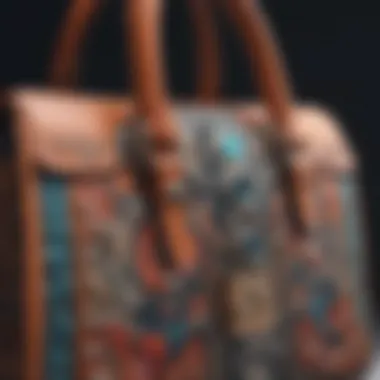

From Past to Present
When we think about color block designs in handbags, it’s useful to consider where these trends began. The roots of color blocking can be traced back to the 1960s, a time when bold colors and abstract shapes started to dominate art and fashion, influenced heavily by artists like Piet Mondrian. The movement revolved around merging contrasting colors in striking designs. Over the decades, these artistic ideals filtered into accessories, particularly handbags, as designers began experimenting with different hues, textures, and patterns.
Fast forward to today, and color block handbags have blossomed into a staple of modern fashion. They have moved from niche runway looks to mainstream staples. No longer confined to the avant-garde, these bags now appear in every major retailer and on the arms of style-savvy individuals worldwide. A typical example seen in vibrant hues often includes combinations like navy blue with mustard yellow or soft lavender paired with deep green. This contemporary evolution signifies an embrace of boldness and a celebration of individual expression in fashion.
Influential Designers in the Color Blocking Scene
Several designers have played pivotal roles in shaping the narrative of color block handbags. Their unique visions and talents pushed boundaries, showcasing color blocking as not merely a trend but a legitimate design technique that can convey brand identity.
- Pierre Cardin was one of the earliest adaptors in the 1960s who recognized the potential of color blocking, turning handbags into wearable art. His playful designs inspired many to follow suit.
- Christian Dior took the world by storm with his innovative approach during the 1980s. Here, block colors were not just about vibrancy; they also emphasized structure and silhouette, integrating colors with a strategic outlook.
- Kate Spade redefined color blocking in the early 2000s, bringing a fresh take to the concept through whimsical patterns that appealed to a younger demographic.
These designers, alongside many others, have influenced not only the aesthetics of color block handbags but also their role within the larger context of fashion as a means of personal expression and sophistication.
As we look at these evolutions, it is essential to appreciate the progress made in design philosophies and consumer preferences over the decades. Each shift in color block handbag design represents not just a change in taste but a broader cultural statement.
Key Features of Color Block Designer Handbags
When diving into the realm of color block designer handbags, it's essential to hone in on the key features that set these pieces apart in the fast-paced world of fashion. Understanding these distinctive elements not only enhances one's appreciation of the craftsmanship involved but also aids in making informed decisions when selecting the right bag for your wardrobe. Each handbag tells a story through its design and materials, making them an integral part of modern style.
Material Selection
Material choice plays a pivotal role in the appeal and longevity of color block handbags. Designers often harness an array of materials, leading to bags that aren't just visually striking but also functional and durable.
Leather is a traditional staple, renowned for its resilience and luxury feel. However, many contemporary designers opt for canvas or synthetic materials, providing both affordability and an eco-conscious alternative.
- Leather: Often used gives an upscale touch, becoming a softer masterpiece with time. Its ability to maintain shape while developing a unique patina adds character.
- Canvas: This material provides a casual vibe, making it ideal for day-to-day use. It’s lightweight and often more accessible in terms of price.
- Synthetic: With advancements in textile technology, many brands lean towards eco-friendly synthetic options that mimic the feel of traditional leather without the ethical concerns.
Choosing the right material depends on lifestyle, durability needs, and personal aesthetics. . .
Signature Design Elements
Signature design elements are what really make color block handbags pop. These unique traits distinguish one brand from another and set trends across the fashion landscape.
For example, consider how stitching patterns can define the style. Some designers embrace bold, contrasting stitching to enhance their color combinations while others may opt for subtle stitches that allow the colors to speak for themselves. The hardware accents—like zippers, buckles, or clasps—often play a supporting role, yet they are fundamental to the overall feel, either emphasizing luxury or casual chic, depending on the execution.
- Shape: From structured totes that command attention to slouchy hobo styles that embody a relaxed attitude.
- Proportions: The size relative to the color blocks can elicit different visual responses. A small bag can seem fun, while a large bag offers functionality.
By paying attention to these signature elements, fashion enthusiasts can better understand the intentions behind each piece and elevate their personal style.
Color Combinations and Their Impact
Arguably the heart and soul of color block design, the color combinations used in handbags have the potential to evoke a myriad of emotions and impressions. Color theory isn't just for artists; it's a critical aspect of fashion.
Warm colors, such as reds and yellows, often convey excitement and confidence. Conversely, cool colors like blues and greens tend to promote calmness and elegance. The impact of these colors can shift depending on the occasion, making combinations an essential thought to ponder when selecting a bag.
- Contrasting Colors: Bold combinations, like royal blue paired with bright orange, are eye-catching and can serve as focal points in an outfit.
- Monochromatic Schemes: Often seen as sophisticated, this approach uses variations of the same hue for a seamless, refined look.
- Pastels and Neutrals: These selections bring about a more understated elegance, perfect for those who prefer subtle sophistication.
It's vital to consider the emotional resonance of colors in fashion. As color block handbags continue to evolve, the creative options within this domain may keep changing, but the fundamental principles of color selection will always underpin the designs.
"In fashion, the palette can make or break an outfit. Understanding how to use color blocks can set a trend before it even hits the runway."
With insights into these key features, it becomes evident that color block designer handbags offer more than just a functional accessory; they serve as vital expressions of individuality and style. Delving into material selection, signature design elements, and the profound influence of color combinations provides a greater depth to one's appreciation of these striking fashion statement pieces.
Color Block Handbags in Contemporary Fashion
Color block handbags hold a distinctive position in today’s fashion landscape. They’re not just bags; they're a statement of individuality and creativity. In a world where everyone is trying to express their personal style, these handbags allow wearers to access a playful yet polished look. The ability to combine various colors and textures speaks volumes about one's fashion sensibility.
Current Trends in the Market
The current market for color block handbags is witnessing a surge, driven mostly by a growing appetite for bold fashion choices. Designers are experimenting widely, combining bright colors and unexpected patterns to create pieces that stand out. According to trend reports, popular color schemes include vibrant hues like fuchsia paired with soft pastels or deep navy with radiant yellows.
"In a saturated market, color block handbags are a breath of fresh air, proving that creativity has no bounds."
Shoppers are leaning towards brands that offer limited editions or unique collections that cater to niche styles. The popularity of these bags has also made them a must-have for social media influencers and bloggers, who love showcasing their vibrant styles on platforms like Instagram.
Key Trends to Note:
- Neon and Pastels: Overlapping neon shades paired with soft pastels yield a striking visual effect.
- Mixed Textures: Combining leather with canvas or suede provides a tactile dimension that enhances the appeal.
- Smart Casual: Fashion enthusiasts are blending these bags with both casual and formal outfits, making them versatile for any occasion.
Celebrity Endorsements and Influence
Celebrities play a crucial role in shaping fashion trends, and color block handbags are no exception. Icons of the entertainment industry have frequently flaunted these accessories, elevating them from mere fashion items to coveted pieces within their luxury collections. Look at how A-list stars like Zendaya and Rihanna have embraced this style in various public appearances, each time pushing the envelope further.


Their influence goes beyond mere aesthetics. When a prominent figure endorses a color block handbag, it often leads to increased visibility and sales for that specific design. This reaction can be instantaneous; as soon as a celebrity is spotted with a unique color block bag, the demand for it spikes, resulting in brands scrambling to meet consumer interest.
Influential Figures:
- Zendaya: Known for mixing bold colors effortlessly, she has made a name for her daring handbag choices.
- Rihanna: This music mogul often opts for one-of-a-kind pieces that showcase her individual flair.
- Harry Styles: His gender-fluid approach to fashion has seen him push the boundaries of traditional handbag designs, encouraging a broader acceptance of bold color combinations.
Styling Tips for Color Block Handbags
Color block handbags, with their bold combinations and eye-catching designs, are a striking addition to fashion ensembles. Whether you are a seasoned designer or a style-savvy enthusiast, understanding how to incorporate these bags into your wardrobe can transform your look. The right styling tips can enhance your outfit, showcase your personality, and keep you on trend.
Matching with Outfits
When it comes to matching outfits with color block handbags, consider the color wheel as your best friend. Harmonizing colors can create a cohesive look while standing out in a crowd. It is beneficial to choose one predominant color from your bag and use it as a base for your attire.
- Monochrome Magic: Dressing in varying shades of a single color alongside your handbag can unify your appearance. A light blue handbag with dark blue hues creates a visually soothing effect.
- Contrasting Colors: For those feeling adventurous, pair complementary colors for a striking contrast. A vibrant green bag can look stunning with shades of red, provided the tones do not clash.
These combinations, though seemingly simple, can significantly amp up an outfit.
Accessorizing with Color Block Bags
Accessorizing with color block handbags is crucial to achieving an ultimate style statement. While these bags often speak volumes on their own, they can also play a supportive role in your overall look.
- Keep It Simple: When your handbag is already a burst of color, it’s wise to keep other accessories minimal. For instance, wearing neutral jewelry allows your handbag to shine without overwhelming the outfit.
- Layer Smartly: If you love layering, try to select pieces that include hints of the colors from your bag. A scarf or hat in a similar hue can harmonize the ensemble without competing for attention.
- Footwear Fusion: A great trick is to find shoes that incorporate one of the colors from your handbag. This connection creates a polished finish while maintaining a playful vibe.
"The beauty of fashion lies in exploration; don’t be afraid to experiment with what works best for you."
Building a wardrobe around these principles can amplify the impact of color block handbags, ensuring they remain a standout feature of your personal style.
Sustainable Practices in Handbag Design
The fashion industry, particularly the world of handbags, has experienced a significant shift towards sustainability. Color block designer handbags are no exception. As consumers become more conscious of environmental issues and ethical concerns, sustainable practices in handbag design are not just beneficial—they are increasingly essential. Focusing on sustainable practices helps designers create impactful pieces that resonate with value-driven customers.
This section explores key factors involving sustainable practices in handbag design and emphasizes their necessity in today's market.
Ethical Sourcing of Materials
When it comes to handbags, the choice of materials can make all the difference, not only in aesthetics but also in ethics. Designers are now prioritizing ethically sourced materials to ensure their products do not contribute to environmental degradation or labor exploitation. You may find companies opting for vegan leather, organic cotton, or even recycled materials.
- Vegan Leather: Instead of animal-derived leather, brands are using synthetic or plant-based alternatives such as cork or pineapple leather, often called Pinatex. This shift caters to a growing vegan market and reduces dependency on traditional leather production.
- Organic Cotton: Utilizing organic cotton minimizes chemical use and promotes sustainable agricultural practices. By choosing this material, designers can support farmers who engage in environmentally friendly farming methods.
- Recycled Materials: Some color block handbags incorporate elements from recycled plastics or other materials. This not only diverts waste from landfills but also reduces the need for virgin resources.
By shining light on ethical sourcing, handbag designers showcase their commitment to a more sustainable future while appealing to conscientious customers. A handbag that is both stylish and responsible tends to have greater appeal.
The Rise of Eco-conscious Designers
The rise of eco-conscious designers signifies a trend towards blending creativity with accountability. Many contemporary designers are not just creating handbags for aesthetic appeal but are also narrating stories of responsibility through their work. Consumers are attracted to labels that embody an awareness of social and environmental issues, leading to a new wave of designers.
- Green Certifications: Some brands pursue certifications that affirm their commitment to sustainability, such as the Global Organic Textile Standard (GOTS) or Fair Trade certifications. These marks assure buyers that the products are produced following environmentally and socially responsible practices.
- Transparent Supply Chains: Designers are becoming more transparent about their supply chains, detailing where and how materials are sourced. This transparency builds trust and engages consumers who value authenticity in the brands they support.
- Innovative Designs: Eco-conscious designers often use innovative techniques to minimize waste. For instance, they might design handbags that can easily be dismantled at the end of their life cycle, allowing for recycling and reusing materials.
Embracing sustainability doesn't just fulfill a market need; it elevates the brand's image and connects deeply with consumers who seek meaningful purchase choices.
"Sustainability is not a trend, it is the fabric of a future we must secure together in the fashion industry."
As color block designer handbags increasingly reflect sustainable practices, they gain importance not only as style statements but as symbols of progress towards ethical fashion. This movement toward sustainability is likely to shape the future of fashion in profound ways.
Investment Value of Designer Handbags
When we talk about designer handbags, it's easy to get lost in the allure of aesthetics and craftsmanship. However, the investment value of these accessories holds equal importance in today’s fashion landscape. Understanding this investment aspect is vital, whether you are a collector, a fashionable enthusiast, or a retailer. Designer handbags are not merely functional pieces; they are assets that can appreciate and provide returns over time. This opens up a layer of complexity that every stakeholder in the fashion community should grasp.
Key elements contributing to the investment value of color block designer handbags include:
- Brand Prestige: Handbags from brands like Chanel, Louis Vuitton, and Hermès are often seen as status symbols. The prestige surrounding these brands translates directly into their market value.
- Rarity: Limited edition or unique pieces can fetch a premium. The less available the handbag, the more individuals are willing to pay for it.
- Condition: The state of the handbag significantly affects its resale potential. Well-maintained bags, even from older collections, may retain or even increase in value.
Not only do these elements enhance their market value over time, but they also foster a culture of collectibility among fashion aficionados.
Understanding Market Value
To truly navigate the investment landscape of designer handbags, one must understand market value. This term encapsulates the price that buyers are willing to pay versus what sellers are asking. The fluctuation can be influenced by trends, economic factors, and changes within the fashion industry. Color block handbags, in particular, have surged in popularity due to their striking design and versatility, making them a sought-after item for many.
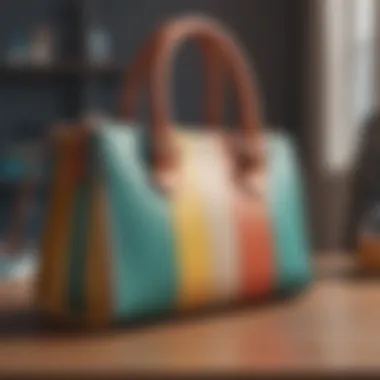

Researching sales data, attending auctions, and tracking online resale platforms can provide a clearer picture of market dynamics. Key points to reflect on include:
- Past Sales: Look at auction results or resale platforms like The RealReal or Vestiaire Collective to gauge recent transaction prices.
- Current Trends: Pay attention to social media influencers and celebrity endorsements. They can drive demand and, consequently, market prices.
- Fashion Weeks: Major fashion events reveal emerging trends. Handbags featured prominently in these shows often see a spike in interest and value.
"A deeper understanding of the market helps collectors not just to buy, but to invest wisely in handbags that can appreciate over time."
Resale and Collectibility
The resale market for designer handbags has transformed the way consumers view these items. What once might have been considered just a fashion purchase is now often seen as a strategic investment. The collectibility factor cannot be ignored—some buyers are hunting for handbags resembling pieces of art that tell a story.
Consider the following aspects:
- Authenticity: Genuine pieces with certificates or purchase receipts are more appealing and command higher prices. Buyers often gravitate towards bags that can be verified for authenticity.
- Trends in Collecting: The trends often resemble those in fine art. Older models from renowned designers may gain popularity as fashion styles recycle.
- Online Platforms: Websites like Rebag and Poshmark are popular avenues for buying and reselling, letting collectors expand their wardrobes while allowing others to partake in luxury without the premium price tag.
Investing in color block designer handbags is not without its risks, but for those willing to do their homework and understand their market, the benefits can be significantly rewarding.
Where to Buy Color Block Designer Handbags
Finding the right place to buy color block designer handbags is as crucial as choosing the handbag itself. The market offers a wide range of options, and knowing where to look can help you snag the ideal piece that suits your style and budget; it also factors in authenticity and availability. Navigating this landscape involves understanding the benefits, specific considerations, and how various purchasing channels can meet distinct needs.
Online Retailers vs. Boutique Stores
When it comes to purchasing color block designer handbags, one must often weigh the advantages of online retailers against boutique stores. The choice typically depends on personal preferences and also how one values distinct shopping experiences.
Online retailers provide the convenience of shopping anytime and anywhere. Websites like Amazon or luxury-specific platforms such as Net-a-Porter offer a plethora of options, complete with customer reviews and often better prices. However, the downside might include concerns about authenticity, especially with high-end brands.
On the flip side, boutique stores offer a tactile experience. You can feel the materials, inspect the craftsmanship, and often receive personalized service from knowledgeable staff. Still, boutique shops can sometimes carry limited stock and higher price tags, which can be a dealbreaker for some.
A concise list of pros for each option includes:
- Online Retailers:
- Boutique Stores:
- Convenience and accessibility
- Wider range of choices
- Often competitive prices
- Personalized shopping experience
- Guaranteed authenticity
- Opportunity to support local businesses
Ultimately, a savvy shopper may do a bit of both—browsing online for styles and prices while visiting boutiques for the final purchase.
Navigating Sales and Discounts
Keeping an eye out for sales and discounts can be a game-changer when it comes to investing in color block designer handbags. Seasonal sales, holiday promotions, and flash sales often present excellent opportunities to save. However, one must tread carefully amidst the excitement.
Researching and signing up for newsletters from your favorite stores can help you stay in the loop. These newsletters often provide exclusive access to sales or even extra discounts that aren't publicly advertised.
Also, consider joining loyalty programs or following brands and retailers on social media. Promotions can spread quickly through these channels, and social media often features code-based discounts or flash sales meant exclusively for followers.
"With the right timing, one can turn what seems to be a dream handbag into a practical reality."
Lastly, keep an eye on resale markets like TheRealReal or Vestiaire Collective. These platforms can provide gently used items at a fraction of the original price, often making high-end fashion more accessible. Understanding these strategies can make a significant difference in your shopping journey.
Closure: The Future of Color Block Designer Handbags
In the ever-shifting panorama of fashion, color block designer handbags stand out not only as a statement of style but also as a reflection of broader trends in consumer behavior and societal values. These bags are more than mere accessories; they act as canvases where creativity meets craftsmanship, beckoning designers to explore a myriad of combinations and innovations. As we look to the future, the anticipated trajectory of these handbags highlights several important elements worth considering.
Color block handbags have proved to be a versatile genre within the handbag arena, and their continual evolution hints at an exciting future.
Anticipating Future Trends
The impending future for color block handbags is likely to be marked by a blend of sustainability and tech-integration. Designers are increasingly leaning towards the use of eco-friendly materials, much like vegan leather, which not only reduces the environmental footprint but also gains favor among socially conscious consumers. Further, the infusion of technology into these bags, like embedded charging ports or smart features, enhances functionality while preserving aesthetic integrity.
And let’s not forget the emerging popularity of customizability, where consumers can select color combinations or even add personal designs, creating one-of-a-kind pieces that reflect individual tastes. This trend intertwines personal expression with traditional craftsmanship, potentially leading to a renaissance in bespoke designer handbags.
As brands like Balenciaga and Prada have started focusing on limited edition runs, exclusivity paired with individuality will likely fuel a resurgence in the appeal of color block designs.
Enduring Appeal in Fashion
Despite the ebb and flow of trends, color block handbags continue to maintain their allure among consumers. There's something intrinsically bold and captivating about the juxtaposition of colors that allows for endless expression. These bags accommodate various outfits, bridging the gaps between casual and formal wear seamlessly.
Fashion is circular; what’s old is new again, and often color blocking serves to revive classic designs with contemporary twists. This timeless nature ensures that color block handbags will always have a seat at the fashion table, striking a chord with both vintage enthusiasts and modern consumers alike.
Moreover, the psychological impact of color can never be overstated in fashion; it affects mood, sets statements, and shapes perceptions. Designers continue to play with colors in innovative ways, making each piece not just a handbag but a mood enhancer and a conversation starter. The capacity of these bags to adapt and prevail in the fashion zeitgeist ensures their position as enduring staples, capable of transforming with each season’s pulse while holding onto their distinctive flair.
The unique characteristics of color block designer handbags create a dynamic platform for discussions about art and creativity, marrying both function and style as new avenues of design unfold. As the market continues to evolve, enthusiasts can expect to see engaging trends emerge, shaped by both innovation and tradition in equal measure.

